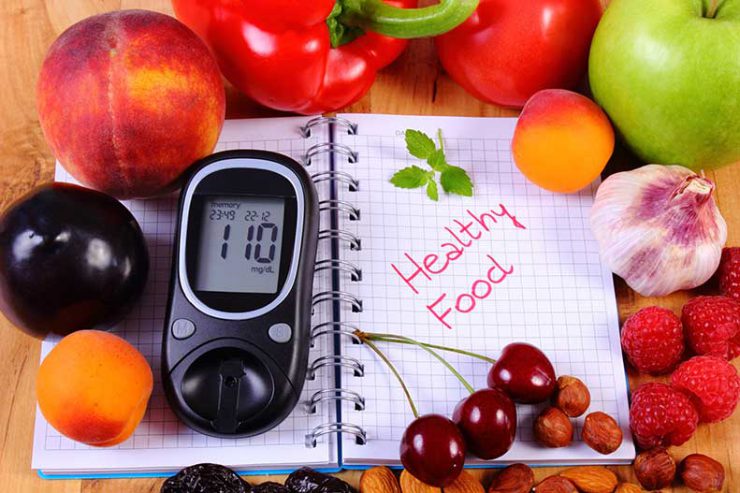Diabetes meal planning starts with eating a well-balanced diet that includes carbohydrates (carbs), protein, and fat.
Carbs are found in starches, fruit, vegetables, milk, yogurt, and sweets. They turn into sugar (glucose) in the body. The body needs carbs for energy. Therefore, it’s important to eat,
Eating too many carbs can raise blood glucose levels too high, but it’s important not to cut out these foods completely. Eating too few carbs may cause your blood glucose to go too low. Therefore, it’s important to eat.
A moderate amount of carbs at each meal, combined with a balanced intake of protein and fat, helps your blood glucose stay in a healthy range.
The number of servings for people with diabetes is:
- Women with diabetes should have about three to four carb choices per meal.
- Men with diabetes should have about four to five carb choices per meal.
- Both men and women can have one to two carb choices for an evening snack.
Use these Eat Smart: Picture Your Plate guidelines for healthy meal planning and portion control.
Healthy Eating Tips for People with Diabetes
- Eat three well-balanced meals a day and a small snack at night. Each meal should contain both carbs and protein. When planning meals, select a variety of foods from each food group and watch your portion sizes.
- Do not skip meals. It’s best to space meals four to five hours apart.
- Increase your fiber intake. Choose whole grain breads and cereals. Eat plenty of vegetables and choose whole fruits instead of fruit juices. When you look at food labels, look for products that contain at least three grams of fiber per serving.
- Reduce fat intake by baking, broiling, and grilling your low-fat foods.
- Stay active. Your blood glucose level will improve if you keep active. Check with your doctor before starting an exercise or walking program.
- Lose weight. If you’re overweight, losing weight gradually — even a small amount (five to 10 pounds) — can help improve your blood glucose level.
- Check with your doctor or dietitian about alcohol intake if you’re taking medicine for your diabetes.
- Read “Nutrition Facts” labels. Sugar-free products may still contain carbs.
Limit your intake and portion sizes of these high-sugar foods to two or three times a week or less:
- Cakes, pies, and cookies
- Candy
- Jelly, jam, and preserves
- Regular ice cream, sherbet, regular and frozen yogurt, fruit ices, and popsicles
- Sugar coated cereals, granola, breakfast or snack bars
- Dried fruit, fruit roll-ups, candied fruit
- Iced sweet breads, coffee cakes, breakfast rolls, and donuts
Avoid the following:
- Table sugar, honey, molasses, and syrup
- Regular soft drinks, fruit drinks (canned or concentrated), and drink mixes with sugar added
- Milkshakes, chocolate milk, and hot cocoa mix
- Canned fruits with heavy syrup
Never Miss a Beat!
Subscribe to Our HealthBeat Newsletter!
Thank you for subscribing!
You can now select the specific newsletters you'd like to receive.
You are already subscribed.
Subscribe to more newsletters in our email preference center.
Sorry, an error occurred. Please try again later.
Get Healthy Tips Sent to Your Phone!
Diabetes Meal Plan: Foods to Choose
Starches
One serving = 15 grams of carbs.
| Foods to choose | Servings |
|---|---|
|
|
Fruits
One serving = 15 grams of carbs.
| Foods to choose | Servings |
|---|---|
|
|
Vegetables (non-starchy)
One serving = 5 grams of carbs. Eat a minimum of two to three servings per day.
| Foods to choose | Servings |
|---|---|
|
|
Milk and dairy
One serving = 12 grams of carbs.
| Foods to choose | Servings |
|---|---|
|
|
Sweets, desserts, and other carbs
One serving = 15 grams of carbs.
| Foods to choose | Servings |
|---|---|
|
|
Protein, Fats, and Other Foods for Diabetics
Protein: meat and meat substitutes
One serving = 0 grams of carbs.
Recommended number of servings:
- Breakfast = 0 to one serving (1 ounce)
- Lunch and dinner = three servings (3 ounces) for women and four servings (4 ounces) for men. Three ounces of meat is roughly equal to the size of a deck of cards
| Foods to choose | Servings |
|---|---|
|
|
Fats
One serving = 0 grams of carbs. Eat one to two servings per meal.
| Foods to choose | Servings |
|---|---|
|
|
Other food and drink choices for a diabetes meal plan
Eat three servings per day.
| Unlimited foods and drinks | Limited foods: 1 piece or 1 tablespoon |
|---|---|
|
|
Sample Menu for a Diabetes Diet
| Breakfast |
|
|---|---|
| Lunch |
|
| Dinner |
|
| Snack |
|
More Diabetes Resources
- Find diabetes support resources and classes near you at the UPMC Diabetes Education and Support Center. You can also learn about diabetes treatment or make an appointment at the
- UPMC Department of Endocrinology.
About Endocrinology
The UPMC Department of Endocrinology stands as a national leader in research of diabetes and endocrine conditions. We partner with the University of Pittsburgh Division of Endocrinology and Metabolism for research and clinical trials. We treat diabetes, obesity, osteoporosis, hormonal disorders, and thyroid disorders at several locations across our communities. We also have specialized Diabetes Centers to help you manage your disease. Find an expert near you.
